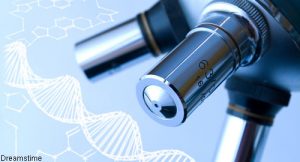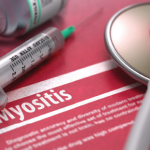 Initially considered a heterogeneous disease, increasingly detailed antibody tests reveal myositis to be a group of distinct diseases that can be phenotyped and treated with increasing precision. One of these newly identified autoantibodies is an antibody to the small ubiquitin-like modifier activating enzyme (SAE). To a large extent, the descriptions of this antibody have come from cohorts in Europe and Asia.1-3 A 2021 study describes the North American experience of anti-SAE dermatomyositis.4
Initially considered a heterogeneous disease, increasingly detailed antibody tests reveal myositis to be a group of distinct diseases that can be phenotyped and treated with increasing precision. One of these newly identified autoantibodies is an antibody to the small ubiquitin-like modifier activating enzyme (SAE). To a large extent, the descriptions of this antibody have come from cohorts in Europe and Asia.1-3 A 2021 study describes the North American experience of anti-SAE dermatomyositis.4
Practical Information
Jemima Albayda, MD, a rheumatologist, director of the Musculoskeletal Ultrasound and Injection Clinic and assistant professor of medicine at Johns Hopkins Medicine, Baltimore, and colleagues report that SAE autoantibodies are clearly associated with the clinical disease of dermatomyositis. Described in the May issue of ACR Open Rheumatology, patients with this clinical phenotype most commonly present with a rash first, followed by muscle involvement, which is often mild, and then varying extramuscular symptoms. The investigators recommend judicious malignancy screening of patients with anti-SAE dermatomyositis because they may be at increased risk for coincident cancer.4
“This is a practical paper,” says Dr. Albayda. “As rheumatologists, we’re always about antibodies and phenotypes.”
She explains that, in their cohort, 100% of patients with anti-SAE dermatomyositis had skin rashes and the skin rashes could be quite severe. In contrast, muscle involvement in these patients was milder and could, in fact, be missed. Although other organs, such as joints, could be affected, lung disease tended to be mild in this cohort.
“Our cohort was more closely aligned with the presentation seen in Western cohorts [as opposed to the Asian cohorts], which was not surprising given that the majority of the patients were Caucasian,” Dr. Albayda says.
Study Details
The retrospective study examined banked sera from 2,127 patients (1,844 with myositis) consecutively evaluated at the Johns Hopkins Myositis Center. The investigators tested the serum using two methods, the first was the Euroimmun test, a multiplex assay. For the second method, the results were compared with immunoprecipitation, the gold standard method. The researchers identified only 43 patients who were anti-SAE autoantibody positive using Euroimmun (15 units or more), a finding consistent with the understanding that SAE autoantibodies are rare.
Of these 43 patients immunoprecipitation confirmed the presence of anti-SAE antibodies in only 19. This finding indicated that, at that lower cutoff of 15 units or more, 24 of 43 patients had false positive tests. When the investigators used a higher cutoff of 36 units or more, they found better agreement between the Euroimmun assay and immunoprecipitation (sensitivity of 100% and a specificity of 88%).
Clinical Presentation
All patients with the SAE autoantibody had skin involvement, and more than half of the patients initially presented clinically with amyopathic dermatomyositis. In patients who eventually developed muscle disease, the muscle involvement occurred as long as 17 months later and tended to be mild. Approximately half (53%) of the patients with the anti-SAE antibodies complained of subjective muscle weakness, and 42% had weakness on examinationMany of the patients with anti-SAE antibodies had inflammatory arthritis and tenosynovitis, and some developed joint contractures.
The cohort included two patients with cancer diagnosed close to the onset of dermatomyositis symptoms: One 66-year-old woman was diagnosed with poorly differentiated carcinoma within three months of her dermatomyositis diagnosis, and one 60-year-old man was diagnosed with moderately differentiated adenocarcinoma of the colon contemporaneous with his dermatomyositis diagnosis. Three other patients in the cohort were diagnosed with cancer more than five years after dermatomyositis symptom onset. Given the small numbers, the study could not confirm an association between anti-SAE antibodies and cancer, but the researchers feel the coincident cancer cases justify judicious malignancy screening.
Lungs: Dr. Albayda says the lung findings surprised her the most. Often, for patients with amyopathic or hypomyopathic dermatomyositis, lung involvement can be so severe that it may be the cause of demise. In contrast, for the patients with anti-SAE dermatomyositis who appeared to be amyopathic, “none of them really complained about lung symptoms,” she says.
Nevertheless, most of the nine patients who had available chest computed tomography (CT) scans had some form of lung involvement even though they had normal to mild restriction in pulmonary function tests. In fact, the investigators had difficulty classifying the interstitial lung disease in these patients and found a novel pattern of peripheral nodules. Although there is always concern about cancer in patients with lung involvement, Dr. Albayda notes none of the patients with lung nodules developed lung cancer. She and her colleagues believe the nodules may reflect an inflammatory process in the lungs, and it has been reassuring that the process appears unlikely to progress to severe lung disease.
Dr. Albayda contrasts the lung findings in patients with anti-SAE dermatomyositis with those of a different subset of patients, those with amyopathic dermatomyositis who can also present with fulminant lung disease. Dr. Albayda suggests knowing the antibody involved can be helpful in predicting disease course. “Antibodies are describing a distinct group within a larger spectrum,” she says.
Bringing Precision Medicine to Rheumatology
Johns Hopkins includes precision medicine in its mission, a mission that, according to Dr. Albayda, calls for better and better phenotyping.
“In the end, rarity doesn’t make a disease more complex or less understandable,” says Dr. Albayda.
Knowing the phenotype may help clinicians in practice. In the case of anti-SAE dermatomyositis, rheumatologists may expect to find a disease dominated by skin rashes, with sometimes milder muscle and lung disease.
Lara C. Pullen, PhD, is a medical writer based in the Chicago area.
References
- Betteridge ZE, Gunawardena H, Chinoy H, et al. Clinical and human leucocyte antigen class II haplotype associations of autoantibodies to small ubiquitin-like modifier enzyme, a dermatomyositis-specific autoantigen target, in U.K. Caucasian adult-onset myositis. Ann Rheum Dis. 2009 Oct;68(10):1621–1625.
- Ge Y, Lu X, Shu X, et al. Clinical characteristics of anti-SAE antibodies in Chinese patients with dermatomyositis in comparison with different patient cohorts. Sci Rep. 2017 Mar 15;7(1):188.
- Betteridge Z, Tansley S, Shaddick G, et al. Frequency, mutual exclusivity and clinical associations of myositis autoantibodies in a combined European cohort of idiopathic inflammatory myopathy patients. J Autoimmun. 2019 Jul;101:48–55.
- Albayda J, Mecoli C, Casciola-Rosen L, et al. A North American cohort of anti-SAE dermatomyositis: Clinical phenotype, testing, and review of cases. ACR Open Rheumatol. 2021 May;3(5):287–295.


